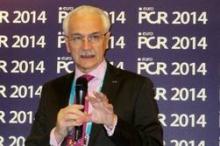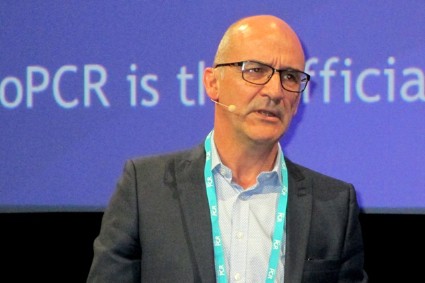User login
PARIS – Transcatheter mitral valve replacement finally took off this year, but it may keep a low profile short-term as investigators gain more clinical experience with transcatheter systems and slowly start to define the right types of patients for this procedure.
Transcatheter mitral valve replacement (TMVR) had something of a false start 2 years ago when CardiAQ announced the first clinical case of a patient with severe mitral valve regurgitation who underwent valve replacement using a transcatheter system at the Heart Centre of Rigshospitalet University Hospital, Copenhagen. Further details of that first case have not yet been reported. It was not until this past May that a second patient underwent TMVR performed by the same Danish team, using a second-generation CardiAQ system.
Also this year came reports on two new TMVR systems, each used for the first time clinically, with five patients treated with the Fortis system made by Edwards Lifesciences, and two treated with the Tiara system made by Neovasc.
"We are finally on the journey of assessment of multiple transcatheter mitral valves. We’ve been saying that for a number of years, but it seems like now we truly will see progress in the mitral space," Dr. Martyn Thomas said during a talk at the annual congress of the European Association of Percutaneous Cardiovascular Interventions.
At the meeting, Dr. Thomas, an interventional cardiologist at St. Thomas’ Hospital, London, and his associate Vinayak Bapat, a cardiac surgeon, reported the experience with five patients treated with the Fortis valve system, including three patients treated by them and their colleagues in London, one patient in Bern, Switzerland, and a fifth who had been treated in Toronto just 4 days before their report at the meeting.
"We have shown that we can deploy the valve, that the valve functions; and we have one patient who is gradually improving, so I believe that the principle is now there as long as we can find the patients" best suited to TMVR, Dr. Thomas said.
"Patient selection is everything," he noted. The selection process is "perhaps more difficult than for transcatheter aortic valve replacement." Patients with severe mitral valve regurgitation often have substantial comorbidities such as left ventricular dysfunction, pulmonary disease, and renal disease, and these may mean a much longer delay to see patient improvement following TMVR compared with after an aortic valve is replaced, he noted.
"Valve replacement seeks to eliminate mitral regurgitation, while clip systems attempt to reduce regurgitation by about one grade. We need to do both, and the difficulty will be determining which patients should get what treatment," Dr. Thomas said in an interview. "Perhaps the highest-risk patients should undergo repair" with a clip, he suggested.
"We need to select patients who will survive the [TMVR] procedure and get through the following 3 months because we may not see any benefit for 3-6 months, in contrast to aortic valve patients who recover and improve very quickly. I believe we will develop a complex algorithm based on each patient’s anatomy that will address the procedure’s risk and its potential to eliminate mitral regurgitation. The mitral clip is a relatively safe procedure, so it will be a much more complex algorithm than for the aortic valve."
A second report at the meeting reviewed experience with the first two patients who received the Tiara TMVR system, both at St. Paul’s Hospital in Vancouver, B.C. Like the Fortis valve, the Tiara is delivered by a transapical approach. The Tiara system delivers a mitral valve via a 32F catheter; the size of the Fortis catheter has not been reported, but a spokeswoman for Edwards acknowledged that it was a similarly large catheter and that efforts are ongoing to try to cut the catheter size. The Fortis mitral valve is 29 mm in diameter, while the size of the Tiara valve has not been reported. Procedure times for the two Tiara cases were 20 minutes for the first patient and 12 minutes for the second, reported Dr. Anson W. Cheung, surgical director of cardiac transplantation at St. Paul’s. The Fortis valve cases showed a learning curve similar to that of the Tiara cases, with the Fortis procedure time falling from 93 minutes for the first patient to 34 minutes for the fourth.
"The key is to catch patients before their left ventricle burns out, and to prevent the vicious cycle of high afterloading" that can occur when the mitral valve is replaced, Dr. Cheung said. He reported that his two cases had no complications or left ventricular outflow tract obstruction, and that one patient has now survived more than 3 months and has shown improved heart function and a halving of her baseline blood level of brain natriuretic peptide.
"In patients with aortic stenosis, when you remove the obstructed [aortic] valve, they improve. In patients with mitral regurgitation, who develop very severely depressed left ventricular function, once you correct the regurgitation it increases stress on the ventricle and they can get into trouble," commented Dr. William Wijns, codirector of the Cardiovascular Center in Aalst, Belgium. "The complexity of the mitral valve problem is several orders of magnitude greater than with transcatheter aortic valve replacement," Dr. Wijns said.
Dr. Thomas has been a consultant to and has received research support from Edwards, the company developing the Fortis valve. Mr. Bapat has been a consultant to Edwards, Medtronic, and St. Jude and has received research support from Edwards. Dr. Cheung has been a consultant to and received honoraria from Neovasc, the company developing the Tiara valve. Dr. Wijns has received grant support to his institution from Edwards and 15 other companies, and he owns stock in two health care companies and a biotechnology company.
On Twitter @mitchelzoler
We had a phase of several years when the mitral valve programs were working hard to figure out how to get started. There has been a sort of critical mass of learning that has now launched the field, with reports on clinical use of three different systems coming out this year.
The procedural understanding that developed during a decade of work on transcatheter aortic valve replacement has helped us figure out how to do mitral valves by generating a broad base of technique development, for example, an understanding of how to percutaneously deliver prosthetic devices more coaxially. It sounds simple, but it had been a critical obstacle for treating the mitral valve.
 |
|
Other technical challenges of transcatheter mitral valve replacement have been designing replacement valves to fit the noncircular mitral orifice, and the absence of calcium deposits on the mitral valve to help anchor a prosthesis. There has also been improving understanding of patient selection, including which patients are best suited to transcatheter mitral valve replacement and when is the best time in the course of mitral valve disease to intervene.
Although the safety and efficacy of the mitral clip as a transcatheter approach to mitral valve repair are now established, at least half and perhaps as many as three-quarters of patients with severe mitral regurgitation are not good candidates for clip repair. This includes patients with commissural mitral regurgitation because clip placement in corners can be difficult, patients with large jet origins that can be too big to grab with a clip, and patients with calcified mitral valve leaflets that can’t be clipped, so there are plenty of patients for whom transcatheter valve replacement would be better than clipping.
D. Ted Feldman, M.D., is director of cardiac catheterization at North Shore University Health System in Evanston, Ill. He was lead investigator for the EVEREST II trial that established the safety and efficacy of the mitral clip (N. Engl. J. Med 2011;364:1395-1406). He has been a consultant to Abbott Vascular, Boston Scientific, Edwards, and Jenavalve. He made these comments in an interview.
We had a phase of several years when the mitral valve programs were working hard to figure out how to get started. There has been a sort of critical mass of learning that has now launched the field, with reports on clinical use of three different systems coming out this year.
The procedural understanding that developed during a decade of work on transcatheter aortic valve replacement has helped us figure out how to do mitral valves by generating a broad base of technique development, for example, an understanding of how to percutaneously deliver prosthetic devices more coaxially. It sounds simple, but it had been a critical obstacle for treating the mitral valve.
 |
|
Other technical challenges of transcatheter mitral valve replacement have been designing replacement valves to fit the noncircular mitral orifice, and the absence of calcium deposits on the mitral valve to help anchor a prosthesis. There has also been improving understanding of patient selection, including which patients are best suited to transcatheter mitral valve replacement and when is the best time in the course of mitral valve disease to intervene.
Although the safety and efficacy of the mitral clip as a transcatheter approach to mitral valve repair are now established, at least half and perhaps as many as three-quarters of patients with severe mitral regurgitation are not good candidates for clip repair. This includes patients with commissural mitral regurgitation because clip placement in corners can be difficult, patients with large jet origins that can be too big to grab with a clip, and patients with calcified mitral valve leaflets that can’t be clipped, so there are plenty of patients for whom transcatheter valve replacement would be better than clipping.
D. Ted Feldman, M.D., is director of cardiac catheterization at North Shore University Health System in Evanston, Ill. He was lead investigator for the EVEREST II trial that established the safety and efficacy of the mitral clip (N. Engl. J. Med 2011;364:1395-1406). He has been a consultant to Abbott Vascular, Boston Scientific, Edwards, and Jenavalve. He made these comments in an interview.
We had a phase of several years when the mitral valve programs were working hard to figure out how to get started. There has been a sort of critical mass of learning that has now launched the field, with reports on clinical use of three different systems coming out this year.
The procedural understanding that developed during a decade of work on transcatheter aortic valve replacement has helped us figure out how to do mitral valves by generating a broad base of technique development, for example, an understanding of how to percutaneously deliver prosthetic devices more coaxially. It sounds simple, but it had been a critical obstacle for treating the mitral valve.
 |
|
Other technical challenges of transcatheter mitral valve replacement have been designing replacement valves to fit the noncircular mitral orifice, and the absence of calcium deposits on the mitral valve to help anchor a prosthesis. There has also been improving understanding of patient selection, including which patients are best suited to transcatheter mitral valve replacement and when is the best time in the course of mitral valve disease to intervene.
Although the safety and efficacy of the mitral clip as a transcatheter approach to mitral valve repair are now established, at least half and perhaps as many as three-quarters of patients with severe mitral regurgitation are not good candidates for clip repair. This includes patients with commissural mitral regurgitation because clip placement in corners can be difficult, patients with large jet origins that can be too big to grab with a clip, and patients with calcified mitral valve leaflets that can’t be clipped, so there are plenty of patients for whom transcatheter valve replacement would be better than clipping.
D. Ted Feldman, M.D., is director of cardiac catheterization at North Shore University Health System in Evanston, Ill. He was lead investigator for the EVEREST II trial that established the safety and efficacy of the mitral clip (N. Engl. J. Med 2011;364:1395-1406). He has been a consultant to Abbott Vascular, Boston Scientific, Edwards, and Jenavalve. He made these comments in an interview.
PARIS – Transcatheter mitral valve replacement finally took off this year, but it may keep a low profile short-term as investigators gain more clinical experience with transcatheter systems and slowly start to define the right types of patients for this procedure.
Transcatheter mitral valve replacement (TMVR) had something of a false start 2 years ago when CardiAQ announced the first clinical case of a patient with severe mitral valve regurgitation who underwent valve replacement using a transcatheter system at the Heart Centre of Rigshospitalet University Hospital, Copenhagen. Further details of that first case have not yet been reported. It was not until this past May that a second patient underwent TMVR performed by the same Danish team, using a second-generation CardiAQ system.
Also this year came reports on two new TMVR systems, each used for the first time clinically, with five patients treated with the Fortis system made by Edwards Lifesciences, and two treated with the Tiara system made by Neovasc.
"We are finally on the journey of assessment of multiple transcatheter mitral valves. We’ve been saying that for a number of years, but it seems like now we truly will see progress in the mitral space," Dr. Martyn Thomas said during a talk at the annual congress of the European Association of Percutaneous Cardiovascular Interventions.
At the meeting, Dr. Thomas, an interventional cardiologist at St. Thomas’ Hospital, London, and his associate Vinayak Bapat, a cardiac surgeon, reported the experience with five patients treated with the Fortis valve system, including three patients treated by them and their colleagues in London, one patient in Bern, Switzerland, and a fifth who had been treated in Toronto just 4 days before their report at the meeting.
"We have shown that we can deploy the valve, that the valve functions; and we have one patient who is gradually improving, so I believe that the principle is now there as long as we can find the patients" best suited to TMVR, Dr. Thomas said.
"Patient selection is everything," he noted. The selection process is "perhaps more difficult than for transcatheter aortic valve replacement." Patients with severe mitral valve regurgitation often have substantial comorbidities such as left ventricular dysfunction, pulmonary disease, and renal disease, and these may mean a much longer delay to see patient improvement following TMVR compared with after an aortic valve is replaced, he noted.
"Valve replacement seeks to eliminate mitral regurgitation, while clip systems attempt to reduce regurgitation by about one grade. We need to do both, and the difficulty will be determining which patients should get what treatment," Dr. Thomas said in an interview. "Perhaps the highest-risk patients should undergo repair" with a clip, he suggested.
"We need to select patients who will survive the [TMVR] procedure and get through the following 3 months because we may not see any benefit for 3-6 months, in contrast to aortic valve patients who recover and improve very quickly. I believe we will develop a complex algorithm based on each patient’s anatomy that will address the procedure’s risk and its potential to eliminate mitral regurgitation. The mitral clip is a relatively safe procedure, so it will be a much more complex algorithm than for the aortic valve."
A second report at the meeting reviewed experience with the first two patients who received the Tiara TMVR system, both at St. Paul’s Hospital in Vancouver, B.C. Like the Fortis valve, the Tiara is delivered by a transapical approach. The Tiara system delivers a mitral valve via a 32F catheter; the size of the Fortis catheter has not been reported, but a spokeswoman for Edwards acknowledged that it was a similarly large catheter and that efforts are ongoing to try to cut the catheter size. The Fortis mitral valve is 29 mm in diameter, while the size of the Tiara valve has not been reported. Procedure times for the two Tiara cases were 20 minutes for the first patient and 12 minutes for the second, reported Dr. Anson W. Cheung, surgical director of cardiac transplantation at St. Paul’s. The Fortis valve cases showed a learning curve similar to that of the Tiara cases, with the Fortis procedure time falling from 93 minutes for the first patient to 34 minutes for the fourth.
"The key is to catch patients before their left ventricle burns out, and to prevent the vicious cycle of high afterloading" that can occur when the mitral valve is replaced, Dr. Cheung said. He reported that his two cases had no complications or left ventricular outflow tract obstruction, and that one patient has now survived more than 3 months and has shown improved heart function and a halving of her baseline blood level of brain natriuretic peptide.
"In patients with aortic stenosis, when you remove the obstructed [aortic] valve, they improve. In patients with mitral regurgitation, who develop very severely depressed left ventricular function, once you correct the regurgitation it increases stress on the ventricle and they can get into trouble," commented Dr. William Wijns, codirector of the Cardiovascular Center in Aalst, Belgium. "The complexity of the mitral valve problem is several orders of magnitude greater than with transcatheter aortic valve replacement," Dr. Wijns said.
Dr. Thomas has been a consultant to and has received research support from Edwards, the company developing the Fortis valve. Mr. Bapat has been a consultant to Edwards, Medtronic, and St. Jude and has received research support from Edwards. Dr. Cheung has been a consultant to and received honoraria from Neovasc, the company developing the Tiara valve. Dr. Wijns has received grant support to his institution from Edwards and 15 other companies, and he owns stock in two health care companies and a biotechnology company.
On Twitter @mitchelzoler
PARIS – Transcatheter mitral valve replacement finally took off this year, but it may keep a low profile short-term as investigators gain more clinical experience with transcatheter systems and slowly start to define the right types of patients for this procedure.
Transcatheter mitral valve replacement (TMVR) had something of a false start 2 years ago when CardiAQ announced the first clinical case of a patient with severe mitral valve regurgitation who underwent valve replacement using a transcatheter system at the Heart Centre of Rigshospitalet University Hospital, Copenhagen. Further details of that first case have not yet been reported. It was not until this past May that a second patient underwent TMVR performed by the same Danish team, using a second-generation CardiAQ system.
Also this year came reports on two new TMVR systems, each used for the first time clinically, with five patients treated with the Fortis system made by Edwards Lifesciences, and two treated with the Tiara system made by Neovasc.
"We are finally on the journey of assessment of multiple transcatheter mitral valves. We’ve been saying that for a number of years, but it seems like now we truly will see progress in the mitral space," Dr. Martyn Thomas said during a talk at the annual congress of the European Association of Percutaneous Cardiovascular Interventions.
At the meeting, Dr. Thomas, an interventional cardiologist at St. Thomas’ Hospital, London, and his associate Vinayak Bapat, a cardiac surgeon, reported the experience with five patients treated with the Fortis valve system, including three patients treated by them and their colleagues in London, one patient in Bern, Switzerland, and a fifth who had been treated in Toronto just 4 days before their report at the meeting.
"We have shown that we can deploy the valve, that the valve functions; and we have one patient who is gradually improving, so I believe that the principle is now there as long as we can find the patients" best suited to TMVR, Dr. Thomas said.
"Patient selection is everything," he noted. The selection process is "perhaps more difficult than for transcatheter aortic valve replacement." Patients with severe mitral valve regurgitation often have substantial comorbidities such as left ventricular dysfunction, pulmonary disease, and renal disease, and these may mean a much longer delay to see patient improvement following TMVR compared with after an aortic valve is replaced, he noted.
"Valve replacement seeks to eliminate mitral regurgitation, while clip systems attempt to reduce regurgitation by about one grade. We need to do both, and the difficulty will be determining which patients should get what treatment," Dr. Thomas said in an interview. "Perhaps the highest-risk patients should undergo repair" with a clip, he suggested.
"We need to select patients who will survive the [TMVR] procedure and get through the following 3 months because we may not see any benefit for 3-6 months, in contrast to aortic valve patients who recover and improve very quickly. I believe we will develop a complex algorithm based on each patient’s anatomy that will address the procedure’s risk and its potential to eliminate mitral regurgitation. The mitral clip is a relatively safe procedure, so it will be a much more complex algorithm than for the aortic valve."
A second report at the meeting reviewed experience with the first two patients who received the Tiara TMVR system, both at St. Paul’s Hospital in Vancouver, B.C. Like the Fortis valve, the Tiara is delivered by a transapical approach. The Tiara system delivers a mitral valve via a 32F catheter; the size of the Fortis catheter has not been reported, but a spokeswoman for Edwards acknowledged that it was a similarly large catheter and that efforts are ongoing to try to cut the catheter size. The Fortis mitral valve is 29 mm in diameter, while the size of the Tiara valve has not been reported. Procedure times for the two Tiara cases were 20 minutes for the first patient and 12 minutes for the second, reported Dr. Anson W. Cheung, surgical director of cardiac transplantation at St. Paul’s. The Fortis valve cases showed a learning curve similar to that of the Tiara cases, with the Fortis procedure time falling from 93 minutes for the first patient to 34 minutes for the fourth.
"The key is to catch patients before their left ventricle burns out, and to prevent the vicious cycle of high afterloading" that can occur when the mitral valve is replaced, Dr. Cheung said. He reported that his two cases had no complications or left ventricular outflow tract obstruction, and that one patient has now survived more than 3 months and has shown improved heart function and a halving of her baseline blood level of brain natriuretic peptide.
"In patients with aortic stenosis, when you remove the obstructed [aortic] valve, they improve. In patients with mitral regurgitation, who develop very severely depressed left ventricular function, once you correct the regurgitation it increases stress on the ventricle and they can get into trouble," commented Dr. William Wijns, codirector of the Cardiovascular Center in Aalst, Belgium. "The complexity of the mitral valve problem is several orders of magnitude greater than with transcatheter aortic valve replacement," Dr. Wijns said.
Dr. Thomas has been a consultant to and has received research support from Edwards, the company developing the Fortis valve. Mr. Bapat has been a consultant to Edwards, Medtronic, and St. Jude and has received research support from Edwards. Dr. Cheung has been a consultant to and received honoraria from Neovasc, the company developing the Tiara valve. Dr. Wijns has received grant support to his institution from Edwards and 15 other companies, and he owns stock in two health care companies and a biotechnology company.
On Twitter @mitchelzoler
AT EUROPCR 2014



